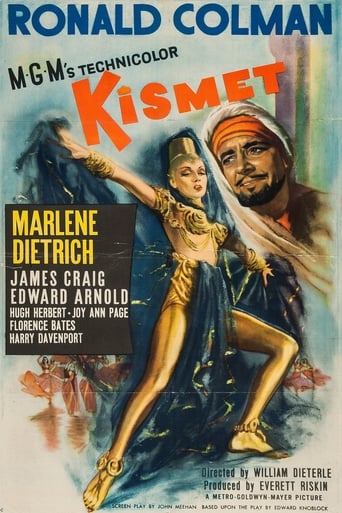Charles Herold (cherold)
When I was younger I might have had the patience for this dumb thing. I used to watch every 1940s movie I could find and enjoyed most of them. I rarely gave up on a movie unless it was wretched, but now I'm older, more impatient and have more stuff to do so if I'm not feeling it I usually bail pretty quickly.This is why I only watched perhaps 20-25 minutes of this movie, which struck me as very dumb Hollywood hokum. The movie seems to start in the middle, with a text intro that describes what has lead up to the present circumstances. Perhaps there's a good reason for this, but it gives the film an odd start. There were a couple of songs in the movie that were utterly tedious, one of them sung by Marlene, who seemed like an odd choice for this film (Marlene should be in a smoky bar or a brothel, not a palace). Everything about this movie just seemed dumb and false.Still, I won't rate it because I haven't seen it all and don't want to unfairly lower its average rating. But I certainly wouldn't give it more than a 5 based on what I saw.
Doghouse-6
Ronald Colman and Edward Arnold (even as a villain) furnish most of the otherwise inadequate charm of this bit of Arabian nights cotton candy that tells of the "King Of the Beggars" who masquerades as a prince each evening while the true local royalty, the Caliph, also roams the streets of Baghdad by night, disguised as a peasant to learn what his subjects really think of him. A premise with promise; full potential unrealized.Marlene Dietrich, while contributing to the decor, is largely wasted as Colman's love interest, a captive queen amused by his extravagant lies but unaware of his true identity. Her best moments come during her verbal sparring matches with Arnold. Colman, as always, makes the most of his role which, if not tailor made for him, certainly appears that way. James Craig gives it a gallant try, but is sorely miscast as the Caliph. Had wartime not curtailed Hollywood's supply of young leading men, Craig's participation herein would have been unlikely. It was simply too much to ask to bend his corn-fed, all-American, big lug nice guy type to the part, and MGM might better have borrowed Turhan Bey from Universal. The Technicolor camera seems to like Joy Page, appearing as Colman's daughter in her second film, but her role gives her fewer opportunities as an actress than her first appearance (in "Casablanca," as the Bulgarian newlywed whose husband tries to win money for exit visas at the roulette table). An almost unrecognizable Florence Bates has a couple good moments as Colman's household servant (begging pays well), but Hugh Herbert, with his 'woo-hoo' persona unaltered from that so familiar in Warners musicals of the previous decade, is rather incongruous as one of Colman's fellow beggars, even in as whimsical a fantasy as this.On a recent TCM screening, host Robert Osborne went on and on about the lavish production values - which he reported offended some during wartime - but I must say, for an MGM production, the money doesn't really show on screen. With its fanciful painted backdrops and stylized sets, it instead resembles one of 20th-Fox's more cut-rate (Technicolor notwithstanding) Grable-Miranda features.All in all, KISMET is an undemanding way to kill a hundred minutes, but aside from the always-welcome presence of Colman and Arnold, not much more can be said of it.
Molly-31
William Dieterle directing, music by Harold Arlen (there's even a tiny bit of the Witch's Guard music at one point!), opulent sets and gorgeous costumes, Ronald Colman -- what more could anyone ask? The film was very carefully crafted. Even the bit players -- especially Henry Davenport and Florence Bates -- were perfect. From the beginning, you are immersed in a magical world, an Iraq that died long ago, the Islam of Arabian Nights and Haroun el-Raschid, a romantic culture with its own philosophies and mysteries. Karsha foretelling the future with a sand reading, the muezzin and his apprentice singing the call to prayer, or the public bathing place that the rascals hide in, give the film a sense not only of unity and atmosphere but of meticulous attention to detail.Dietrich's character was not Greek but Macedonian (like Alexander the Great, another blonde). I could have stood for more authenticity in her dance (especially after the Kraft girls who preceded her -- their Deva Dasi style dance *was* pretty authentic) and that gold paint was a little much. Still, the idea was that Jamilla was wild, and did unconventional things.I do see where it could have been better. Craig in particular sounds jarringly "modern". But you forget that after a while. Modern films don't present this kind of idealism. We have to have everything brought down to sordid reality. A thing like this is good for you after too much "realism" gunk.
Stinkier
Whew! Beautiful colors! But that's it. Remember "Ninotchka?" "Garbo laughs"? Well, in this movie, Edward Arnold, as the evil vizier, laughs and laughs and laughs, and he's not nearly as good looking. And the two young lovers? There is a reason James Craig is not remembered, he has trouble speaking English with any clarity, rhythm or sincerity. And Joy Page, in the words of Humphrey Bogart, should "go back to Bulgaria." (Yes, that was her. James Craig was the second loser she picked for a husband.) Dietrich provides comedy relief, sounding exactly like Madeline Kahn in "Blazing Saddles." Thank goodness they at least have Hugh Herbert popping up from time to time...and, well, don't tell anyone but I LIKED Ronald Colman in this one....And we haven't even gotten to the truly jaw-dropping (as in bad) special effects. If you want to feel good about yourself at someone else's expense, watch.



